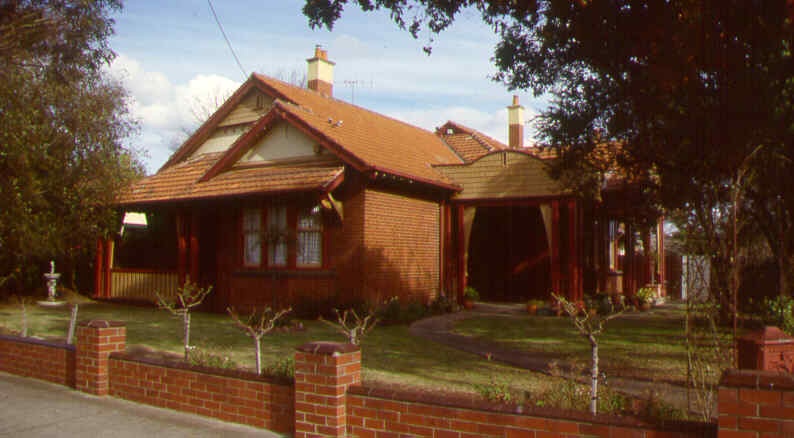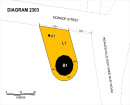FORMER MANAGER'S RESIDENCE, NEWPORT RAILWAY WORKSHOPS
59 CHAMPION ROAD AND 1C PARK CRESCENT WILLIAMSTOWN NORTH, HOBSONS BAY CITY
-
Add to tour
You must log in to do that.
-
Share
-
Shortlist place
You must log in to do that.
- Download report




Statement of Significance
The houses at 57 and 59 Champion Road were built c1915 as residences for the Manager and the Deputy Manager of the Newport Railway Workshops. They were built by AJ Maddock under Victorian Railways Contract 29407, signed 29 September 1915. They replaced two timber double-storey houses built c1889 at the eastern end of the main Workshops site.
The two matching Federation style, single-storey brick houses with tiled roofs are set on large blocks of land on the south side of Champion Road, opposite the Newport Railway Workshops. The houses have been privately owned since c1982.
The residence at 59 Champion Road is of historical and architectural significance to the state of Victoria.
The residence at 59 Champion Road is of historical significance for its strong associations with the Newport Railway Workshops, one of the most important surviving 19th century railway workshops in the world. They were the main workshops of the Victorian Railways for over a century and were one of Victoria's largest and best equipped engineering establishments. The workshops were so important to the Railways and to the Victorian economy that it was considered necessary to provide official railway residences near the complex.
The residence at 59 Champion Road is of architectural importance as an intact example of a Bungalow style suburban villa of the late Federation/Edwardian period. The refined design displays Californian and Craftsman Bungalow influences, as well as remnants of Melbourne’s Queen Anne. It shows treatments of planning and circulation, dominant ridge and gable with projecting secondary gables, and relation of roofs to the plan, which are typical of the Bungalow of this period. Other typical features are window bays with lead-lights, red brick, Marseilles tile, expressed structural timber-work, roughcast and shingles in the gables, and abstracted brackets to the eaves, porches and verandahs. The hierarchy of spaces and related hierarchy of finishes and materials are demonstrative of the type of lifestyle considered appropriate for an occupant of the status of the railway yards manager. At the same time, the plan and form are well adapted to the orientation of the site.
-
-
FORMER MANAGER'S RESIDENCE, NEWPORT RAILWAY WORKSHOPS - History
Contextual History:
In 1883 Breretin and Lewis, architects, prepared designs for a new railway workshop complex to be erected at Newport, to replace earlier facilities at Williamstown. The new complex reputedly based on the design of British railway workshops, was constructed and equipped in 1886 - 88. The main elements of the group of structures comprises a central block of offices with clock tower, a central block of light duty workshops, and east block for light duty woodworking, painting and carriage building, and a west block for the heavy engineering activities of boilermaking, blacksmithing and locomotive and machinery construction.
1905 - 1915 saw a major expansion of the Newport workshops, with cheaper corrugated iron extensions being added onto the 1888 brick buildings, to double the area of enclosed workshops. This followed the decision to manufacture steam locomotives and rolling stock at the workshops instead of purchasing them from commercial suppliers. A further major expansion program in 1925 -30 saw a new complex of large corrugated iron buildings erected and equipped at the eastern end of the site, and the staff increased to about 5,000 men making it one of the largest workshops in Victoria.
History of Place:
The houses at 57 and 59 Champion Road were built c.1915 as residences for the Manager and the Deputy Manager of the Newport Railway Workshops. They were built by A. J. Maddock under Victorian Railways Contract 29407, signed 29 September 1915. They replaced two timber double-storey houses built c.1889 at the eastern end of the main Workshops site. Although No 59 was intended to be the Manager's house, the first resident manager chose No 57 as his residence.FORMER MANAGER'S RESIDENCE, NEWPORT RAILWAY WORKSHOPS - Assessment Against Criteria
Criterion A
The historical importance, association with or relationship to Victoria's history of the place or object.
The residence at 59 Champion Road has historical importance for its associations with the former Newport Railway Workshops, the main workshops for the Victorian Railways for over a century and one of the best surviving 19th century railway workshops in the world.Criterion B
The importance of a place or object in demonstrating rarity or uniqueness.Criterion C
The place or object's potential to educate, illustrate or provide further scientific investigation in relation to Victoria's cultural heritage.Criterion D
The importance of a place or object in exhibiting the principal characteristics or the representative nature of a place or object as part of a class or type of places or objects.Criterion E
The importance of the place or object in exhibiting good design or aesthetic characteristics and/or in exhibiting a richness, diversity or unusual integration of features.
59 Champion Road is important as a fine design displaying Californian and Craftsman Bungalow influences as well as remnants of the Queen Anne style.Criterion F
The importance of the place or object in demonstrating or being associated with scientific or technical innovations or achievements.Criterion G
The importance of the place or object in demonstrating social or cultural associations.Criterion H
Any other matter which the Council considers relevant to the determination of cultural heritage significanceFORMER MANAGER'S RESIDENCE, NEWPORT RAILWAY WORKSHOPS - Permit Exemptions
General Exemptions:General exemptions apply to all places and objects included in the Victorian Heritage Register (VHR). General exemptions have been designed to allow everyday activities, maintenance and changes to your property, which don’t harm its cultural heritage significance, to proceed without the need to obtain approvals under the Heritage Act 2017.Places of worship: In some circumstances, you can alter a place of worship to accommodate religious practices without a permit, but you must notify the Executive Director of Heritage Victoria before you start the works or activities at least 20 business days before the works or activities are to commence.Subdivision/consolidation: Permit exemptions exist for some subdivisions and consolidations. If the subdivision or consolidation is in accordance with a planning permit granted under Part 4 of the Planning and Environment Act 1987 and the application for the planning permit was referred to the Executive Director of Heritage Victoria as a determining referral authority, a permit is not required.Specific exemptions may also apply to your registered place or object. If applicable, these are listed below. Specific exemptions are tailored to the conservation and management needs of an individual registered place or object and set out works and activities that are exempt from the requirements of a permit. Specific exemptions prevail if they conflict with general exemptions. Find out more about heritage permit exemptions here.Specific Exemptions:General Conditions:
1. All exempted alterations are to be planned and carried out in a manner which prevents damage to the fabric of the registered place or object.
2. Should it become apparent during further inspection or the carrying out of alterations that original or previously hidden or inaccessible details of the place or object are revealed which relate to the significance of the place or object, then the exemption covering such alteration shall cease and the Executive Director shall be notified as soon as possible.
3. If there is a conservation policy and plan approved by the Executive Director, all works shall be in accordance with it.
4. Nothing in this declaration prevents the Executive Director from amending or rescinding all or any of the permit exemptions.
5. Nothing in this declaration exempts owners or their agents from the responsibility to seek relevant planning or building permits from the responsible authority where applicable.
Exterior
* Minor repairs and maintenance which replace like with like.
* Removal of extraneous items such as, pipe work, ducting, wiring, antennae, aerials etc, and making good.
* Installation or repair of damp proofing by either injection method or grouted pocket method.
* Regular garden maintenance.
* Installation, removal or replacement of garden watering systems.
* Laying, removal or replacement of paving in the back and side gardens.
Interior
* Painting of previously painted walls and ceilings provided that preparation or painting does not remove evidence of the original paint or other decorative scheme.
* Removal of paint from originally unpainted or oiled joinery, doors, architraves, skirtings and decorative strapping.
* Installation, removal or replacement of carpets and/or flexible floor coverings.
* Installation, removal or replacement of curtain track, rods, blinds and other window dressings.
* Installation, removal or replacement of hooks, nails and other devices for the hanging of mirrors, paintings and other wall mounted artworks.
* Refurbishment of bathrooms, toilets and or en suites including removal, installation or replacement of sanitary fixtures and associated piping, mirrors, wall and floor coverings.
* Installation, removal or replacement of kitchen benches and fixtures including sinks, stoves, ovens, refrigerators, dishwashers etc and associated plumbing and wiring.
* Installation, removal or replacement of ducted, hydronic or concealed radiant type heating provided that the installation does not damage existing skirtings and architraves and provided that the location of the heating unit is concealed from view.
* Installation, removal or replacement of electrical wiring provided that all new wiring is fully concealed and any original light switches, pull cords, push buttons or power outlets are retained in-situ. Note: if wiring original to the place was carried in timber conduits then the conduits should remain in-situ.
* Installation, removal or replacement of bulk insulation in the roof space.
* Installation, removal or replacement of smoke detectors.
Minor WorksAny minor works that in the opinion of the Executive Director will not adversely affect the heritage significance of the place may be exempt from the permit requirements of the Heritage Act. A person proposing to undertake minor works may submit a proposal to the Executive Director. If the Executive Director is satisfied that the proposed works will not adversely affect the heritage values of the site, the applicant may be exempted from the requirement to obtain a heritage permit. If an applicant is uncertain whether a heritage permit is required, the permits co-ordinator Heritage Victoria should be contacted.
Exterior of any buildings on Lot 2 Park Crescent
* Minor repairs and maintenance which replace like with like.
* Removal of extraneous items such as, pipe work, ducting, wiring, antennae, aerials etc, and making good.
* Installation or repair of damp proofing by either injection method or grouted pocket method.
* Regular garden maintenance.
* Installation, removal or replacement of garden watering systems.
* Laying, removal or replacement of paving in the back and side gardens.
Interior of any buildings on Lot 2 Park Crescent*All works to the interiorFORMER MANAGER'S RESIDENCE, NEWPORT RAILWAY WORKSHOPS - Permit Exemption Policy
The cultural heritage significance of the residence at 59 Champion Road is principally due to its historical associations with the former Newport Railway Workshops. The residence also has architectural significance as an essentially intact example of a skilfully designed Bungalow style suburban villa of the late Edwardian period. The hierarchy of interior spaces and related hierarchy of finishes and materials which were employed is significant in demonstrating the status of the manager of the workshops.
The exemptions policy recognises that some alterations have occurred, mainly to the interior, and that further upgrading of service spaces will take place in the future. The purpose of the permit exemptions is to allow works that do not impact on the significance of the place to occur without the need for a permit. Alterations that impact on the significance of the exterior and interior are subject to permit applications.
-
-
-
-
-
WILLIAMSTOWN CEMETERY
 Victorian Heritage Register H1837
Victorian Heritage Register H1837 -
FORMER DEPUTY MANAGER'S RESIDENCE, NEWPORT RAILWAY WORKSHOPS
 Victorian Heritage Register H1839
Victorian Heritage Register H1839 -
FORMER NEWPORT RAILWAY WORKSHOPS
 Victorian Heritage Register H1000
Victorian Heritage Register H1000
-
"1890"
 Yarra City
Yarra City -
"AMF Officers" Shed
 Moorabool Shire
Moorabool Shire -
"AQUA PROFONDA" SIGN, FITZROY POOL
 Victorian Heritage Register H1687
Victorian Heritage Register H1687
-
1 Brockenshire Street
 Yarra City
Yarra City -
1 Bundara Street
 Yarra City
Yarra City -
1 Forster Street
 Hobsons Bay City
Hobsons Bay City
-
-















